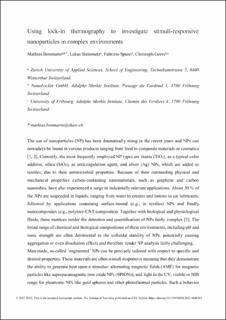Bitte benutzen Sie diese Kennung, um auf die Ressource zu verweisen:
https://doi.org/10.21256/zhaw-22639Langanzeige der Metadaten
| DC Element | Wert | Sprache |
|---|---|---|
| dc.contributor.author | Bonmarin, Mathias | - |
| dc.contributor.author | Steinmetz, Lukas | - |
| dc.contributor.author | Spano, Fabrizio | - |
| dc.contributor.author | Geers, Christoph | - |
| dc.date.accessioned | 2021-06-11T13:30:04Z | - |
| dc.date.available | 2021-06-11T13:30:04Z | - |
| dc.date.issued | 2021 | - |
| dc.identifier.issn | 1094-6969 | de_CH |
| dc.identifier.issn | 1941-0123 | de_CH |
| dc.identifier.uri | https://digitalcollection.zhaw.ch/handle/11475/22639 | - |
| dc.description | © 2021 IEEE. Personal use of this material is permitted. Permission from IEEE must be obtained for all other uses, in any current or future media, including reprinting/republishing this material for advertising or promotional purposes, creating new collective works, for resale or redistribution to servers or lists, or reuse of any copyrighted component of this work in other works. | de_CH |
| dc.description.abstract | The use of nanoparticles (NP) has been dramatically rising in the recent years and NPs can nowadays be found in various products ranging from food to composite materials or cosmetics. Currently, the most frequently employed NP types are titania (TiO 2 ), as a typical color additive, silica (SiO 2 ), as anticoagulation agent, and silver (Ag) NPs, which are added to textiles, due to their antimicrobial properties. Because of their outstanding physical and mechanical properties, carbon-containing nanomaterials, such as graphene and carbon nanotubes, have also experienced a surge in industrially relevant applications. About 30% of the NPs are suspended in liquids, ranging from water to creams and lotions to car lubricants, followed by applications containing surface-bound (e.g., in textiles) NPs and finally nanocomposites (e.g., polymer-CNT composites). Together with biological and physiological fluids, these matrices render the detection and quantification of NPs fairly complex. The broad range of chemical and biological compositions of these environments, including pH and ionic strength, are often detrimental to the colloidal stability of NPs, potentially causing aggregation or even dissolution effects and therefore render NP analysis fairly challenging. | de_CH |
| dc.language.iso | en | de_CH |
| dc.publisher | IEEE | de_CH |
| dc.relation.ispartof | IEEE Instrumentation & Measurement Magazine | de_CH |
| dc.rights | Licence according to publishing contract | de_CH |
| dc.subject.ddc | 620: Ingenieurwesen | de_CH |
| dc.title | Using lock-in thermography to investigate stimuli-responsive nanoparticles in complex environments | de_CH |
| dc.type | Beitrag in wissenschaftlicher Zeitschrift | de_CH |
| dcterms.type | Text | de_CH |
| zhaw.departement | School of Engineering | de_CH |
| zhaw.organisationalunit | Institute of Computational Physics (ICP) | de_CH |
| dc.identifier.doi | 10.1109/MIM.2021.9448265 | de_CH |
| dc.identifier.doi | 10.21256/zhaw-22639 | - |
| zhaw.funding.eu | No | de_CH |
| zhaw.issue | 4 | de_CH |
| zhaw.originated.zhaw | Yes | de_CH |
| zhaw.pages.end | 10 | de_CH |
| zhaw.pages.start | 3 | de_CH |
| zhaw.publication.status | acceptedVersion | de_CH |
| zhaw.volume | 24 | de_CH |
| zhaw.publication.review | Peer review (Publikation) | de_CH |
| zhaw.webfeed | Sensors and Measuring Systems | de_CH |
| zhaw.author.additional | No | de_CH |
| zhaw.display.portrait | Yes | de_CH |
| Enthalten in den Sammlungen: | Publikationen School of Engineering | |
Dateien zu dieser Ressource:
| Datei | Beschreibung | Größe | Format | |
|---|---|---|---|---|
| 2021_Bonmarin-etal_Lock-in-thermography-nanoparticles.pdf | Accepted Version | 852.41 kB | Adobe PDF |  Öffnen/Anzeigen |
Zur Kurzanzeige
Bonmarin, M., Steinmetz, L., Spano, F., & Geers, C. (2021). Using lock-in thermography to investigate stimuli-responsive nanoparticles in complex environments. IEEE Instrumentation & Measurement Magazine, 24(4), 3–10. https://doi.org/10.1109/MIM.2021.9448265
Bonmarin, M. et al. (2021) ‘Using lock-in thermography to investigate stimuli-responsive nanoparticles in complex environments’, IEEE Instrumentation & Measurement Magazine, 24(4), pp. 3–10. Available at: https://doi.org/10.1109/MIM.2021.9448265.
M. Bonmarin, L. Steinmetz, F. Spano, and C. Geers, “Using lock-in thermography to investigate stimuli-responsive nanoparticles in complex environments,” IEEE Instrumentation & Measurement Magazine, vol. 24, no. 4, pp. 3–10, 2021, doi: 10.1109/MIM.2021.9448265.
BONMARIN, Mathias, Lukas STEINMETZ, Fabrizio SPANO und Christoph GEERS, 2021. Using lock-in thermography to investigate stimuli-responsive nanoparticles in complex environments. IEEE Instrumentation & Measurement Magazine. 2021. Bd. 24, Nr. 4, S. 3–10. DOI 10.1109/MIM.2021.9448265
Bonmarin, Mathias, Lukas Steinmetz, Fabrizio Spano, and Christoph Geers. 2021. “Using Lock-in Thermography to Investigate Stimuli-Responsive Nanoparticles in Complex Environments.” IEEE Instrumentation & Measurement Magazine 24 (4): 3–10. https://doi.org/10.1109/MIM.2021.9448265.
Bonmarin, Mathias, et al. “Using Lock-in Thermography to Investigate Stimuli-Responsive Nanoparticles in Complex Environments.” IEEE Instrumentation & Measurement Magazine, vol. 24, no. 4, 2021, pp. 3–10, https://doi.org/10.1109/MIM.2021.9448265.
Alle Ressourcen in diesem Repository sind urheberrechtlich geschützt, soweit nicht anderweitig angezeigt.